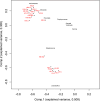Equine stomachs harbor an abundant and diverse mucosal microbiota
- PMID: 22307294
- PMCID: PMC3318809
- DOI: 10.1128/AEM.06252-11
Equine stomachs harbor an abundant and diverse mucosal microbiota
Abstract
Little is known about the gastric mucosal microbiota in healthy horses, and its role in gastric disease has not been critically examined. The present study used a combination of 16S rRNA bacterial tag-encoded pyrosequencing (bTEFAP) and fluorescence in situ hybridization (FISH) to characterize the composition and spatial distribution of selected gastric mucosal microbiota of healthy horses. Biopsy specimens of the squamous, glandular, antral, and any ulcerated mucosa were obtained from 6 healthy horses by gastroscopy and from 3 horses immediately postmortem. Pyrosequencing was performed on biopsy specimens from 6 of the horses and yielded 53,920 reads in total, with 631 to 4,345 reads in each region per horse. The microbiome segregated into two distinct clusters comprised of horses that were stabled, fed hay, and sampled at postmortem (cluster 1) and horses that were pastured on grass, fed hay, and biopsied gastroscopically after a 12-h fast (cluster 2). The types of bacteria obtained from different anatomic regions clustered by horse rather than region. The dominant bacteria in cluster 1 were Firmicutes (>83% reads/sample), mainly Streptococcus spp., Lactobacillus spp. and, Sarcina spp. Cluster 2 was more diverse, with predominantly Proteobacteria, Bacteroidetes, and Firmicutes, consisting of Actinobacillus spp. Moraxella spp., Prevotella spp., and Porphyromonas spp. Helicobacter sp. sequences were not identified in any of 53,920 reads. FISH (n = 9) revealed bacteria throughout the stomach in close apposition to the mucosa, with significantly more Streptococcus spp. present in the glandular region of the stomach. The equine stomach harbors an abundant and diverse mucosal microbiota that varies by individual.
Figures







Similar articles
-
Examination of equine glandular stomach lesions for bacteria, including Helicobacter spp by fluorescence in situ hybridisation.BMC Microbiol. 2010 Mar 19;10:84. doi: 10.1186/1471-2180-10-84. BMC Microbiol. 2010. PMID: 20298612 Free PMC article.
-
Characterization of the fecal bacteria communities of forage-fed horses by pyrosequencing of 16S rRNA V4 gene amplicons.FEMS Microbiol Lett. 2012 Jan;326(1):62-8. doi: 10.1111/j.1574-6968.2011.02434.x. Epub 2011 Nov 2. FEMS Microbiol Lett. 2012. PMID: 22092776
-
Characterization of Gastric Microbiota in Twins.Curr Microbiol. 2017 Feb;74(2):224-229. doi: 10.1007/s00284-016-1176-8. Epub 2016 Dec 12. Curr Microbiol. 2017. PMID: 27957630
-
In-depth snapshot of the equine subgingival microbiome.Microb Pathog. 2016 May;94:76-89. doi: 10.1016/j.micpath.2015.11.002. Epub 2015 Nov 10. Microb Pathog. 2016. PMID: 26550763
-
Effect of the proton pump inhibitor omeprazole on the gastrointestinal bacterial microbiota of healthy dogs.FEMS Microbiol Ecol. 2012 Jun;80(3):624-36. doi: 10.1111/j.1574-6941.2012.01331.x. Epub 2012 Mar 12. FEMS Microbiol Ecol. 2012. PMID: 22324305
Cited by
-
Effects of the Ingestion of Ripe Mangoes on the Squamous Gastric Region in the Horse.Animals (Basel). 2022 Nov 9;12(22):3084. doi: 10.3390/ani12223084. Animals (Basel). 2022. PMID: 36428312 Free PMC article.
-
High nutrient availability reduces the diversity and stability of the equine caecal microbiota.Microb Ecol Health Dis. 2015 Aug 4;26:27216. doi: 10.3402/mehd.v26.27216. eCollection 2015. Microb Ecol Health Dis. 2015. PMID: 26246403 Free PMC article.
-
Changes in the equine fecal microbiota associated with the use of systemic antimicrobial drugs.BMC Vet Res. 2015 Feb 3;11:19. doi: 10.1186/s12917-015-0335-7. BMC Vet Res. 2015. PMID: 25644524 Free PMC article.
-
Unveiling the gastric microbiota: implications for gastric carcinogenesis, immune responses, and clinical prospects.J Exp Clin Cancer Res. 2024 Apr 19;43(1):118. doi: 10.1186/s13046-024-03034-7. J Exp Clin Cancer Res. 2024. PMID: 38641815 Free PMC article. Review.
-
Identification of a core bacterial community within the large intestine of the horse.PLoS One. 2013 Oct 24;8(10):e77660. doi: 10.1371/journal.pone.0077660. eCollection 2013. PLoS One. 2013. PMID: 24204908 Free PMC article.
References
-
- Acosta-Martinez V, Dowd SE, Sun Y, Allen V. 2009. Tag-encoded pyrosequencing analysis of bacterial diversity in a single soil type as affected by management and land use. Soil Biol. Biochem. 4:2762–2770
-
- Alexander F. 1972. Certain aspects of the physiology and pharmacology of the horse's digestive tract. Equine Vet. J. 4:166–169
-
- Al Jassim RAM, Scott T, Trebbin AL, Trott D, Pollitt CC. 2005. The genetic diversity of lactic acid producing bacteria in the equine gastrointestinal tract. FEMS Microbiol. Lett. 248:75–81 - PubMed
-
- Al Jassim RAM. 2006. Supplementary feeding of horses with processed sorghum grains and oats. Anim. Feed Sci. Tech. 125:33–44
-
- Andrews FM, Buchanan BR, Elliot SB, Clairday NA, Edwards LH. 2005. Gastric ulcers in horses. J. Anim. Sci. 83:E18–E21
Publication types
MeSH terms
Substances
Grants and funding
LinkOut - more resources
Full Text Sources
Miscellaneous

